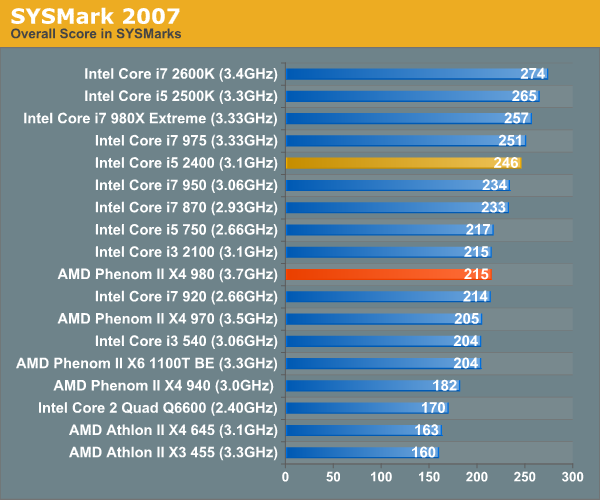AMD Phenom II X4 980 Black Edition Review
by Anand Lal Shimpi on May 2, 2011 10:42 PM ESTGeneral Performance: SYSMark 2007
Our journey starts with SYSMark 2007, the only all-encompassing performance suite in our review today. The idea here is simple: one benchmark to indicate the overall performance of your machine. SYSMark 2007 ends up being more of a dual-core benchmark as the applications/workload show minimal use of more than two threads.

Adobe Photoshop CS4 Performance
To measure performance under Photoshop CS4 we turn to the Retouch Artists’ Speed Test. The test does basic photo editing; there are a couple of color space conversions, many layer creations, color curve adjustment, image and canvas size adjustment, unsharp mask, and finally a gaussian blur performed on the entire image.
The whole process is timed and thanks to the use of Intel's X25-M SSD as our test bed hard drive, performance is far more predictable than back when we used to test on mechanical disks.
Time is reported in seconds and the lower numbers mean better performance. The test is multithreaded and can hit all four cores in a quad-core machine.











78 Comments
View All Comments
Sivar - Tuesday, May 3, 2011 - link
In "Gaming Performance", the last two charts show Core i5 frame rates which are a little on the low side.Thanks for saving the images in PNG format though. You'd be surprised how many technical authors save images which have large areas of flat color in JPG format. :)
gevorg - Tuesday, May 3, 2011 - link
How many times does AMD wants to win the worst power consumption crown?mattgmann - Tuesday, May 3, 2011 - link
Amazing that Amd's Phenom II is still clock for clock on par with the old q6600. It might have a few more refinements in coding, and a higher clock speeds, but it's raw horsepower is still on par with a 5 year old chip.AMD is two gens behind intel in performance, I don't see how BD can reasonably expect to be in the same ballpark as sandy bridge. I'm sure they'll compete in a budget based scenario, but the high end is a moon shot. With Intel's x58 replacement is in the que I just don't see AMD even sniffing a piece of the high end action.
abhaxus - Tuesday, May 3, 2011 - link
You know, I am with you. But who believed that AMD would ever have released the Athlon and beaten Intel for as long as they did? I have hope, and we all should, for our own wallet's sake. AMD's inability to beat intel is the reason my Q6600 is still a fast CPU (granted, overclocked to 3.2ghz, it isn't exactly stock).Nothing would make me happier than a fast AMD cpu to make me consider upgrading.
LancerVI - Tuesday, May 3, 2011 - link
I admit that I'm an Intel man. But I've got to say. I hope AMD pulls BD out and comes out guns blazing. My wallet could use the help!!!Intel has been able to charge whatever for quite sometime now. It needs some furious competition to help drive prices down.
...at least I hope.
mattgmann - Tuesday, May 3, 2011 - link
Don't get me wrong, I'd love it if AMD were neck and neck with intel. Competition helps my wallet and keeps high end gear in my beige box.It's just at this point in the game, BD cannot logically advance far enough past their last generation to compete with Intel's lineup. I'm sure that BD will be priced competitively and give some trouble to the low end sandy bridge chips. It won't be because their more advanced though, it'll be because the AMD chip will be a power hoggin, quad+ core with unlocked multipliers up against a lean locked down intel dual core.
DMisner - Tuesday, May 3, 2011 - link
They COULD be the high end.. if they made the move to ARM.Still though, I have faith in AMD.
aegisofrime - Tuesday, May 3, 2011 - link
Make the move to ARM, and abandon the x86 software market? Not a wise move.Unless they used some sort of dynamic translator a la Transmeta Crusoe.
Shadowmaster625 - Tuesday, May 3, 2011 - link
All they need to do is add a couple ARM cores to their existing bobcat design. Then they need to get in bed with microsoft and make sure that windows 8 properly implements schedulers that can seamlessly integrate ARM and x86 code. If AMD and microsoft both execute correctly, an 18 watt brazos chip is all we'd need for a desktop OS once the windows kernel is all ARM. Office would follow in a year. Antivirus and photo/video editing would go to the SIMDs. The x86 cores would only handle our legacy apps.extide - Wednesday, May 4, 2011 - link
Why would you EVER want to do that? Then you would have developers having to build apps that have to run on two architectures at the same time? If you want to do fixed function stuff do something like Intels Quick Sync for video, and then leave an x86 chip as an x86 chip.